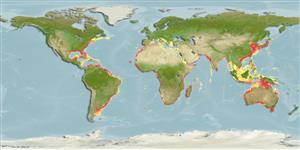Classification / Names
Common names from other countries
Référence principale
Taille / Poids / Âge
Max length : 330 cm TL mâle / non sexé; (Ref. 27549); common length : 250 cm TL mâle / non sexé; (Ref. 6077); poids max. publié: 158.8 kg (Ref. 40637)
Length at first maturity
Lm ?, range 220 - 230 cm
Environnement
; marin récifal; océanodrome (Ref. 51243); profondeur 1 - 191 m (Ref. 247), usually 15 - 25 m (Ref. 43278)
Climat / Gamme
Subtropical, preferred 26°C (Ref. 107945); 45°N - 48°S, 100°W - 155°E
Distribution
Circumtropical: Except perhaps the eastern Pacific (Ref. 13568). Indo-West Pacific: Red Sea and off the coasts of South Africa to Japan, Korea and Australia (Ref. 13568). Present in Arafura Sea (Ref. 9819). Western Atlantic: Gulf of Maine to Argentina. Old record from Bermuda, south Brazil (Ref. 26938). Eastern Atlantic: Mediterranean to Cameroon. Northwest Atlantic: Canada (Ref. 5951).
Pays | Zones FAO | Écosystèmes | Occurrences | Introductions
Description synthétique
Épines dorsales (Total): 0; Rayons mous dorsaux (Total): 0; Épines anales 0; Rayons mous anaux: 0. A shark with a short, pointed snout, small eyes, protruding spike-like teeth and small, equal-sized dorsal and anal fins; 1st dorsal fin closer to pelvic than to pectoral fins (Ref. 5578). Caudal fin with a pronounced subterminal notch and a short ventral lobe (Ref. 13575). Pale brown or grey, paler below, with dark spots that appear faded in adults; fins plain (Ref. 6586).
Statut dans la liste rouge de l'IUCN (Ref. 115185)
Menace pour l'homme
Traumatogenic (Ref. 4690)
Utilisations par l'homme
Pêcheries: commercial; pêche sportive: oui
Plus d'informations
RéférencesAquacultureProfil d'aquacultureSouchesGénétiqueFréquences alléliquesHéritabilitéPathologiesTraitementMass conversion
Outils
Articles particuliers
Télécharger en XML
Sources Internet
Estimates of some properties based on models
Phylogenetic diversity index
PD50 = 0.8125 many relatives (e.g. carps) 0.5 - 2.0 few relatives (e.g. lungfishes)
Niveau trophique
4.5 ±0.4 se; Based on diet studies.
Résilience
Très faible, temps minimum de doublement de population supérieur à 14 ans (Fec=2; K=0.14-0.17; tmax=17)
Vulnérabilité
High vulnerability (58 of 100)
Catégorie de prix
